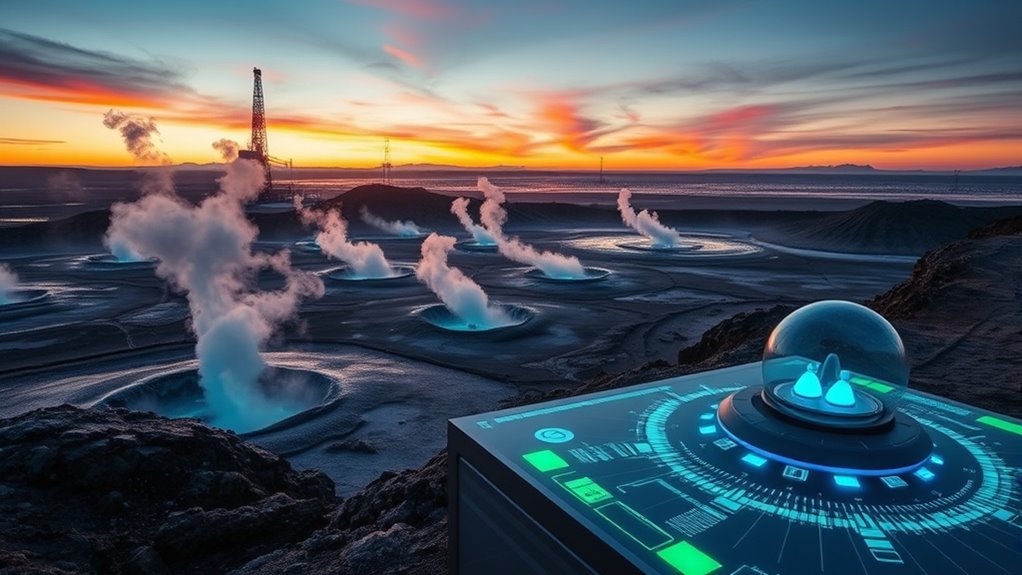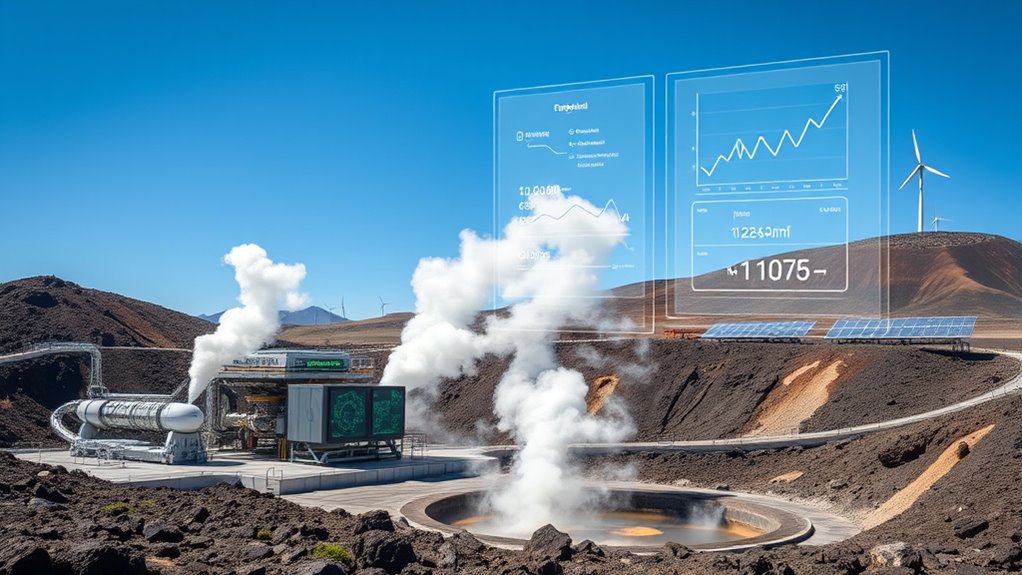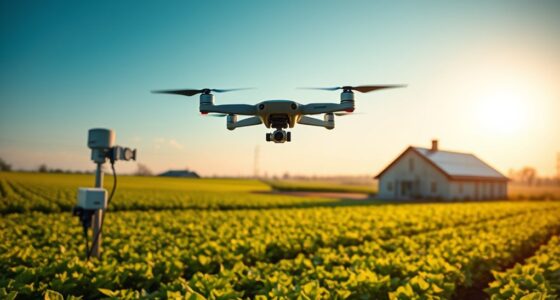AI is transforming geothermal energy by analyzing geological data to pinpoint promising sites, optimizing drilling and exploration, and improving operational performance. It enables real-time monitoring, predictive maintenance, and efficient energy distribution, which helps reduce costs and increase energy output. AI also supports sustainable practices by lowering environmental impacts. To see how these cutting-edge technologies work together and revolutionize renewable energy, keep exploring the exciting world of AI in geothermal systems.
Key Takeaways
- AI enhances site selection by analyzing geological data for high-precision reservoir identification.
- Machine learning models optimize resource extraction, increasing energy output and reducing operational costs.
- Real-time monitoring and predictive maintenance improve plant efficiency and prevent equipment failures.
- AI-driven seismic imaging and data interpretation accelerate exploration, lowering risks and costs.
- Integration of AI in energy distribution ensures reliable supply, demand forecasting, and grid management.

Have you ever wondered how artificial intelligence is transforming geothermal energy? AI is revolutionizing this sector by streamlining operations, enhancing resource management, and reducing risks. You’ll find that AI tools like machine learning, cognitive AI, and generative AI are at the forefront of improving efficiency across the entire geothermal lifecycle. These technologies analyze vast amounts of geological and operational data in real time, enabling smarter decision-making that maximizes resource extraction while minimizing costs. As a result, geothermal projects become more sustainable, environmentally friendly, and economically viable. By leveraging AI, you can expect increased energy output, decreased downtime, and lower operational expenses, all contributing to a more competitive renewable energy landscape.
In resource assessment, AI plays a vital role in site selection by identifying the most promising locations for geothermal development. You can rely on AI models to analyze geological data with high precision, helping you pinpoint reservoirs with the greatest potential. Predictive modeling then allows you to simulate how reservoirs will behave under various extraction scenarios, reducing uncertainties and improving planning accuracy. AI also enhances risk management by detecting potential issues early in exploration and development phases, saving time and money. The efficiency of these assessments is greatly improved because AI automates complex data analysis, cutting down on the traditional lengthy processes and costly explorations.
When it comes to optimizing geothermal operations, AI offers real-time monitoring systems that provide continuous data on plant performance. You can use this information to make immediate adjustments, boosting efficiency and output. Predictive maintenance is another benefit, where AI detects signs of equipment wear or failure before they happen, preventing costly breakdowns and reducing downtime. Operational costs decrease as AI fine-tunes plant processes and scales up operations smoothly without sacrificing efficiency. This scalability ensures that as demand grows, your geothermal systems can expand effectively while maintaining peak performance. Additionally, integrating AI with projector technology can help visualize complex data and system performance metrics, aiding decision-makers in understanding operational trends better.
AI also enhances exploration and drilling by improving seismic imaging and geological analysis, helping you locate reservoirs more accurately and efficiently. Generative AI contributes to better drill bit design, especially in challenging environments, lowering drilling costs and reducing exploration risks. Additionally, AI’s ability to interpret seismic data quickly and accurately leads to better reservoir identification, saving you time and money during the exploration phase.
Finally, AI supports the entire energy production and distribution process. It optimizes power plant operations, ensuring consistent energy output and seamless integration into existing grids. AI-driven demand prediction and distribution management improve efficiency, while fault detection and management keep the system reliable. Ultimately, AI helps reduce the carbon footprint of geothermal energy production, making it a cleaner and more sustainable energy source. In all these ways, AI is transforming geothermal energy into a smarter, more efficient, and environmentally friendly solution for our future energy needs.
Frequently Asked Questions
How Does AI Improve Geothermal Reservoir Modeling Accuracy?
You might wonder how AI boosts geothermal reservoir modeling accuracy. It does this by analyzing large datasets, revealing hidden patterns, and improving predictions of subsurface properties. AI models, like deep learning, achieve high accuracy and simulate various scenarios to optimize operations. Real-time monitoring and continuous updates help you detect anomalies early and refine your models, leading to more reliable, precise reservoir insights and better decision-making.
What Are the Cost Benefits of AI Integration in Geothermal Projects?
You’ll find that integrating AI into geothermal projects offers significant cost benefits. It reduces exploration and drilling expenses by better predicting suitable sites and reservoirs. Real-time monitoring and predictive maintenance cut operational costs and prevent downtime. Additionally, AI optimizes resource use, increases efficiency, and automates tasks, lowering labor costs. These improvements lead to more reliable, cost-effective geothermal energy production, helping you maximize returns while minimizing financial risks.
Can AI Predict Geothermal Energy Production Fluctuations?
You can rely on AI to predict geothermal energy production fluctuations. It analyzes real-time data from sensors, geophysical patterns, and historical trends to identify potential changes before they happen. By recognizing early signs of fluctuations, AI allows you to make timely adjustments, optimize operations, and prevent unexpected downtimes. This proactive approach helps maintain stable energy output, enhances efficiency, and reduces operational risks in your geothermal energy system.
How Is AI Used in Geothermal Drilling Optimization?
You can use AI to optimize geothermal drilling by leveraging machine learning models that analyze vast datasets to determine the best drilling parameters. AI systems provide real-time monitoring to adjust operations on the fly, reducing risks and downtime. They predict subsurface conditions, helping you plan efficient drilling paths. This approach cuts costs, enhances safety, and increases the accuracy of resource extraction, making geothermal projects more viable and sustainable.
What Are Future AI Innovations Expected to Impact Geothermal Energy?
You’re curious about future AI innovations shaping geothermal energy. Expect smarter site selection tools that analyze more complex data, making exploration cheaper and faster. AI will further optimize reservoir stimulation and operational efficiency through real-time analytics, reducing costs and risks. Additionally, advanced predictive models will better forecast energy demand, allowing you to scale geothermal capacity smoothly. These innovations will make geothermal energy more reliable, affordable, and adaptable worldwide.
Conclusion
As you harness AI’s power, you become the architect of a greener future, where geothermal energy blooms like a radiant sunrise. With every algorithm you deploy, you’re revealing hidden Earth treasures, turning fiery depths into a sustainable symphony. Embrace this technological magic, and watch as your efforts ignite a revolution—transforming our planet into a thriving sanctuary of clean, endless energy. Together, you’re fueling hope and forging a legacy that burns bright for generations to come.











